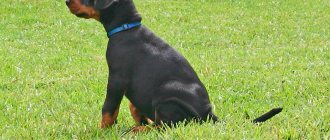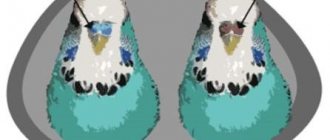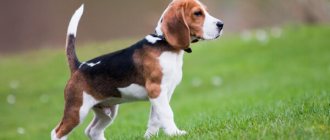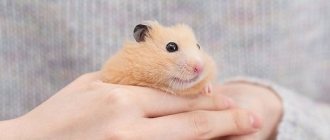Puppy age
From birth until 2 weeks of age, your puppy will be blind, deaf and completely dependent on his mother. Between 2 and 4 weeks of age, he will see and hear the world around him for the first time. Along with his growing brethren, he will become very mobile to explore new places, sounds and smells. Your Labrador Retriever puppy's baby teeth will begin to erupt in the 4th week. And by 8 weeks, your puppy will be able to leave his mother, brothers and sisters and come to you as a full-fledged companion.
Table of average height and weight for male and female Labradors:
| Age, months | Weight, kg | Height at withers, cm | Chest circumference, cm | Head circumference, cm | Muzzle circumference, cm | Muzzle length, cm | Pastern girth, cm |
| 1 month | 3.4-3.8 | 23-23.5 | 37-38 | 27-28 | 17 | 3.5-4 | 9 |
| 2 months | 7-8 | 30-32.5 | 45-56 | 29-32.5 | 20.5-22 | 4.5-5.5 | 10.5-11 |
| 3 months | 12-14 | 39.5-42 | 51-56 | 34-36 | 23-24 | 6-7 | 11.5-12 |
| 4 months | 17-19 | 44-46 | 60-64 | 38-39 | 24-26 | 7-8 | 11.5-12 |
| 5 months | 21-22 | 48-51 | 66-68 | 41-42 | 25-27 | 7.5-8.5 | 11.5-12.5 |
| 6 months | 24-26 | 50-55 | 67-70 | 42-43 | 27-28 | 7.5-9 | 11.5-12.5 |
| 7 months | 26-28 | 52-56 | 69-74 | 43-44 | 28-29 | 7.5-9 | 11.5-13 |
| 8 months | 28-30 | 54-57 | 70-76 | 45-46 | 28-30 | 7.5-9 | 11.5-13 |
| 9 months | 29-32 | 54-58 | 70-77 | 46-48 | 28-31 | 7.5-9.5 | 11.5-13.5 |
| 10 months | 30-36 | 54-58 | 70-84 | 46-55 | 28-32 | 7.5-10 | 11.5-14 |
| Adult | 30-40 | 54-58 | 70-86 | 46-56 | 28-32 | 7.5-10 | 11.5-14 |
Dimensions (height at withers, etc.) for an adult Labrador, depending on gender
There is an American standard, according to which the height of females is up to 55 centimeters at the withers, males - up to 57 centimeters.
You can measure your dog at home. The breed standards, in addition to general height and weight, include indicators of head length, cheekbone width, length of the body and front legs, chest girth, wrist girth, muzzle length, distance between the shoulder blades, and leg length.
The Labrador is considered a dog of medium height - not very tall and not too small - and quite large in build.
requirements :
- Wedge-shaped large head.
- Powerful muzzle with large nostrils.
- Strong rounded jaws.
- Straight and level nose.
- The eyes are not very big.
- The tail is moderately long, straight, wider at the base and narrower towards the end.
- The hind legs are more developed than the front legs.
Expert opinion
Tolkachev Andrey Mikhailovich
veterinarian
If a Labrador's weight exceeds the norm (you can check the size chart and try on the dog yourself at home; on average, an adult dog is about thirty kilograms and half a meter in height), then this cannot be ignored. These dogs have a high appetite, they do not know how to control themselves, and apartment pets most often suffer from obesity. Closer to the age of 10, Labradors become overgrown with fat deposits, this can be avoided if the dog is loaded with physical exercise - running, long walks, swimming - one and a half to two active hours a day. You can check for excess weight by lightly pressing the ribs with your fingers: they should be palpable, but individual ribs should not be visible. If a Labrador does not grow more than forty centimeters for a long time - for example, up to a year - then it is too early to panic, perhaps the dog has not yet matured: adult individuals sometimes grow up to one and a half years.
Development from 3 months to a year
At 3 months of age, your active puppy will be ready for home training and exercise. During this time, he will still grow at an accelerated rate, becoming stronger every day. His permanent teeth will start to come in, so provide him with plenty of appropriate chew toys to help ease his toothaches. By 7 months, the Labrador Retriever will become a full-fledged teenager who has reached puberty. If you are going to spay or neuter your dog before the age of 1, then your lab will benefit from this quite a lot.
By this point after puberty, your puppy will have a full set of permanent teeth. This is the right time to begin basic obedience training. Labs are smart and easy to train, which is why they are so often chosen to serve the blind and disabled. Point your buddy in the right direction so that you can have a happy future together.
Official: provisions of the standard
When discussing breed standards, one is tempted to exclaim: “...nothing lasts forever under the moon.” The times of inflexible dogmas and “reinforced concrete” regulations have long since sunk into oblivion. Today, two officially accepted registries of the Labrador Retriever breed peacefully coexist in the international canine community: British and American . The first was declared by the English canine community in 1988, the second was approved and used in the states on March 31, 1994.
The basic differences between the standards are in size and color: as a result, the Labrador community lives “split” into two camps - “island classic” and “overseas new wave”. The FCI is trying in vain to reconcile the “hot heads” and soften the severity of the confrontation, but it’s not working out well. The matter has not yet reached various rings: the average size of a Labrador .
The permissible normal weight of an adult Labrador (male) varies from 30 to 40 kg. The weight of a female Labrador is 25-32 kg. At exhibitions, the word forms “ normal weight of the Labrador breed /an adult Labrador weighs ” are not encouraged; vague formulations like “harmonious balance-development of weight/appearance” are used.
The spread of indicators “ height of the withers of a Labrador ” is not so critical: the height of a male Labrador is 56-58 cm, a female is 54-56 cm. Sexual dimorphism in the breed is minimal: a large (big) and tall male Labrador is simply more brutal and massive than the graceful and graceful Labradors girls
dimensions reign on fashion shows and catwalks (the size of Labrador dog ):
- Labrador breed back length : 58-65cm;
- chest circumference : 70-85cm;
- neck circumference : 39-42cm;
- muzzle circumference – 28-3cm;
Adulthood
Although much of development depends on the individual dog, Labrador Retrievers typically reach their full size by 18 months of age. At this point he will have gained weight, but he should not have any fat. Regular physical exercise will help him develop bones and muscles, and develop a decent constitution in the later stages of development.
The height and weight of a Labrador Retriever depends on many factors. The size of a dog can also be estimated if you have seen its mother and father. According to the American Kennel Club standard, the height of a male Labrador at the withers is 57-62 cm, females - 55-60 cm. The approximate weight of a male is in the range of 29-36 kg, females - 25-32 kg.
Video “Interesting facts about the Labrador breed”
From this video you will learn the secrets of the popular Labrador breed.
Similar article: What is remarkable about the chocolate-colored Labrador?
Recommended Posts
Standard height and weight of the Cane Corso breed by month
How to care for a puppy and an adult Labrador
What is tasty and healthy to feed your Labrador at home?
Weight and height of a German Shepherd puppy by month
British kitten weight by month and breed standard
What to look for and how to choose the right Labrador puppy
Regular checkups with a veterinarian
During the first year, you should take your puppy to the veterinarian regularly for vaccinations and routine checkups. Your veterinarian should weigh him each time to ensure he is the correct weight for his developmental stage. If he is underweight, the veterinarian will advise you on this issue, as well as in the case of overweight. In the second case, you will probably have to slightly reduce its portions and increase the duration of your workouts. Growing puppies need good nutrition, so you should also consult your veterinarian about this.
What to do if your weight is below normal
Monitoring your puppy's development means weighing him periodically. If the dog does not gain weight for a significant period of time, it needs to be dewormed. Then introduce nutrition and vitamins into the diet.
If in this case the puppy remains small, then you need to contact a veterinarian.
NOTE!
There may be health problems: lethargy, reluctance to eat, very poor appetite are the first signs of this.
A dog can also lose weight due to a violation of mineral metabolism. This is typical for puppies and teenagers.
Other factors
In many ways, puppies are what they eat, so feeding your Lab a high-quality food will not only ensure good health, but will also impact his adult size. Ask your veterinarian for recommendations on a good puppy food and the appropriate amount to feed. Malnourished Labradors may grow slower than those receiving quality nutrition. Additionally, if your puppy suffers from a serious illness or disorder, this may also slow down his development and growth.
Labrador is overweight
Labradors are big food lovers. These dogs have an excellent appetite, so they easily gain excess weight. The boy (cable) eats more than the girl. Obesity seriously harms the heart, blood vessels and joints.
Walks should become longer, it is advisable to play outdoor games with the Labrador more often, let him run and jump.
Sometimes the cause of obesity is thyroid disease, then the dog is prescribed a course of treatment.
With age, closer to 10 years, Labradors almost always gain weight and their metabolism slows down. An older dog needs a balanced diet.
If your pet has gained extra pounds, it is urgent to correct its diet and physical activity. This will require consultation with a veterinarian. It is necessary to reduce the amount of carbohydrates in your pet’s diet.
Puppy development and growth
The development of a Labrador can be schematically divided into three stages:
- 1-4 months. The fastest weight gain, the fastest growth.
- 5-8 months. Gradual decline in the pace of development.
- 9-12 months. Slowest growing dog.
This division is also averaged. Some dogs stop growing at 6 months. Some people's weight has been stuck at the same level since they were 9 months old.
Both international, American and British standards allow Labrador retrievers to participate in exhibitions from the age of 1 year.
Photos and videos of puppies
Photos of newborn puppies:
Photos of Labradors at 1 month:
In the photo - Labradors at 3 months:
Photos of four-month-old teenage puppies:
Labradors at six months:
Adult animals at 1 year:
Puppy weight by month
Let's start with how much a healthy dog should weigh. Since the main characteristics are weight and height, we will also talk about what height is considered normal for babies. A special table will help us figure out the size of the puppy.
Age (months)
Weight, kg)
Height (cm)
A healthy Labrador puppy's weight increases by at least 2 kg every month. And if we summarize the entire table, then the dog’s weight should increase 10 times on average in 10 months. The growth of a Labrador also varies from month to month and is finally formed by the year.
In order to monitor the parameters of a Labrador Retriever, you need to measure it at the withers. To do this, you will need, firstly, a centimeter, and secondly, the dog’s good disposition. The baby should not be hungry, and let there be a minimum of irritants around. The retriever grows up to almost a year, so significant changes occur every 30 days. For this reason, measurements are taken on a Labrador show puppy monthly, as it must meet standards in order to take part in shows.
As can be seen from the table, active weight gain occurs as early as 2 months - the weight increases almost 2 times. Already at 3 months, the puppy begins to gain an average of 3 kg in 30 days of life, but by 5 months the baby should already have two-thirds of the required weight. At 4 months, the dog’s growth at the withers also slows down. But at 6 months, a maximum of 8 cm should be missing from the norm. On the one hand, if you observe your four-legged friend monthly, then not such big changes occur to him: his weight increases by two kilograms, and his height increases by a couple of centimeters. One way or another, the puppy must follow the required parameters upon reaching a certain age, otherwise the path to exhibition events will be closed to him.
To ensure that the pet does not deviate from the norm, the owner must provide it with proper care, a balanced diet and sufficient exercise. Excess pounds are just as dangerous as being underweight. Be attentive to your baby, because he is entirely dependent on you.
Compliance with the parameters is not only a sign of elitism, but also of health.











